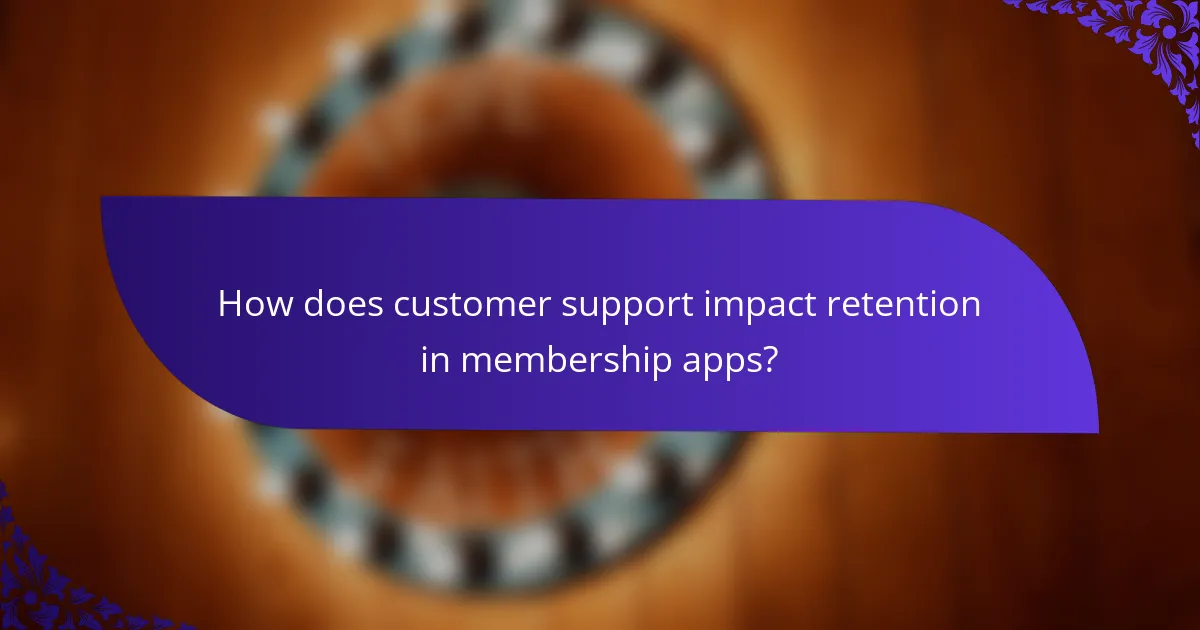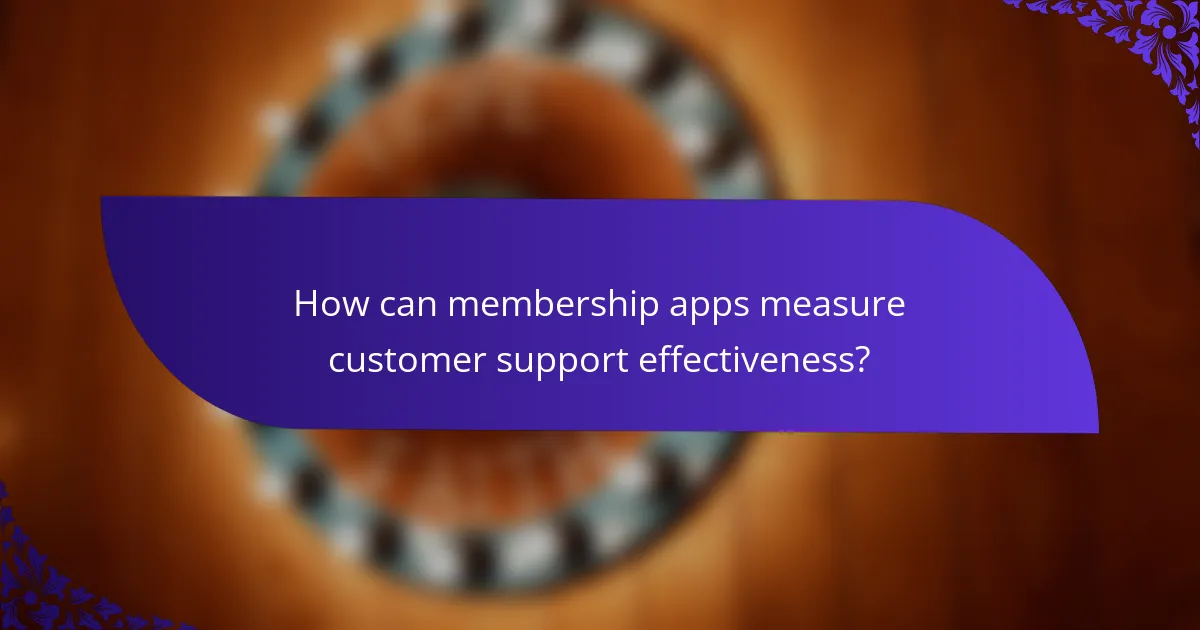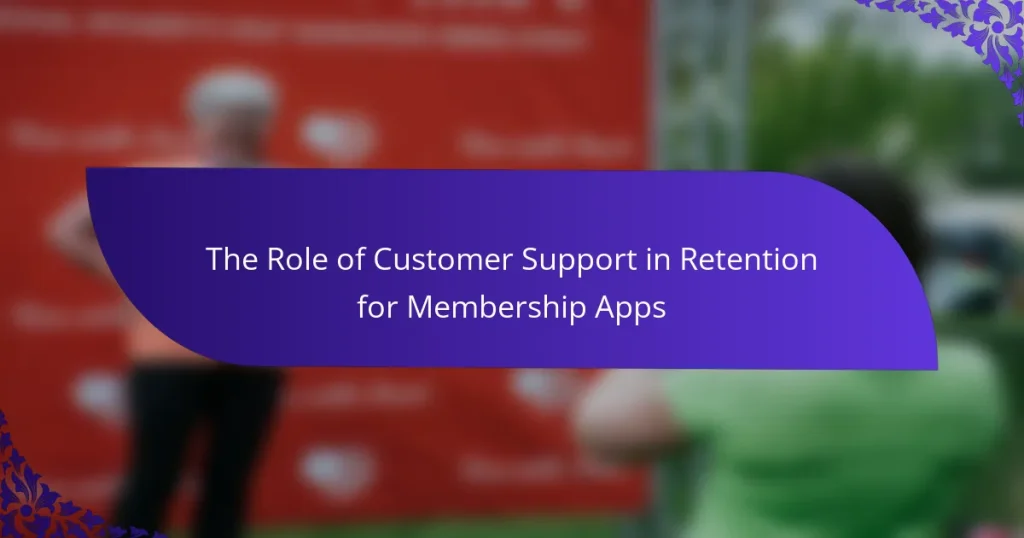Customer support is essential for retaining users of membership apps, as it directly addresses their concerns and enhances their overall experience. By implementing effective support strategies, such as 24/7 live chat and personalized assistance, apps can significantly boost user satisfaction and engagement, ultimately reducing churn rates and fostering long-term loyalty.

How does customer support impact retention in membership apps?
Customer support plays a crucial role in retaining users of membership apps by addressing their concerns and enhancing their overall experience. Effective support can lead to higher satisfaction, lower churn rates, and increased engagement, all of which are vital for long-term retention.
Improves user satisfaction
High-quality customer support directly improves user satisfaction by providing timely assistance and resolving issues efficiently. When users feel valued and heard, they are more likely to continue using the app. For instance, quick responses to inquiries can significantly enhance their perception of the service.
Offering multiple support channels, such as chat, email, and phone, can cater to different user preferences, further boosting satisfaction. Ensuring that support representatives are knowledgeable and empathetic also contributes to a positive user experience.
Reduces churn rates
Effective customer support can significantly reduce churn rates by addressing user frustrations before they escalate. When users encounter problems, prompt and effective solutions can prevent them from abandoning the app. For example, if a user experiences a billing issue, resolving it quickly can keep them from canceling their membership.
Regular follow-ups with users who have contacted support can also demonstrate commitment to their satisfaction, further decreasing the likelihood of churn. Implementing feedback loops to learn from support interactions can help identify common issues and improve the overall service.
Enhances user engagement
Customer support enhances user engagement by fostering a sense of community and connection with the app. When users feel supported, they are more likely to explore additional features and participate in community discussions. For instance, proactive outreach to users can encourage them to utilize underused features.
Moreover, providing educational resources and tutorials through customer support can empower users to maximize their experience. Engaged users are not only more likely to renew their memberships but also to recommend the app to others, further driving growth.

What are effective customer support strategies for membership apps?
Effective customer support strategies for membership apps focus on providing timely, personalized assistance to enhance user satisfaction and retention. Key approaches include 24/7 live chat support, personalized email follow-ups, and in-app support features that cater to user needs.
24/7 live chat support
Implementing 24/7 live chat support allows users to receive immediate assistance, which can significantly improve their experience with the app. This real-time interaction helps resolve issues quickly, reducing frustration and increasing the likelihood of continued membership.
When setting up live chat, consider using chatbots for initial queries to filter common questions, while ensuring human agents are available for more complex issues. This combination can enhance efficiency and user satisfaction.
Personalized email follow-ups
Personalized email follow-ups are crucial for maintaining engagement with users after their initial interactions. Sending tailored messages based on user behavior or inquiries can make members feel valued and understood, fostering loyalty.
For effective follow-ups, segment your user base and craft messages that address specific needs or interests. For instance, if a user inquires about a feature, follow up with tips on maximizing its use or related resources.
In-app support features
In-app support features, such as FAQs, tutorials, and feedback forms, empower users to find solutions independently while still providing a safety net for assistance. These tools can enhance user experience by making information readily accessible.
Consider integrating a help center within the app that includes searchable articles and video guides. This can reduce the volume of support requests while ensuring users have the resources they need to navigate the app effectively.

How can technology enhance customer support in membership apps?
Technology can significantly enhance customer support in membership apps by providing faster, more efficient responses and personalized interactions. Tools like AI chatbots, CRM systems, and analytics help streamline support processes, ensuring users receive timely assistance and improving overall satisfaction.
AI chatbots for instant responses
AI chatbots are designed to provide immediate answers to common customer inquiries, reducing wait times and improving user experience. These bots can handle a variety of tasks, such as answering FAQs, guiding users through app features, and even processing simple transactions.
For effective implementation, ensure the chatbot is trained on relevant data and can escalate complex issues to human agents when necessary. This hybrid approach maintains high service quality while maximizing efficiency.
CRM systems for tracking interactions
Customer Relationship Management (CRM) systems allow membership apps to track all interactions with users, providing a comprehensive view of customer history and preferences. This data enables support teams to offer personalized assistance and follow up on previous issues, fostering stronger relationships.
When selecting a CRM, consider features like integration with existing tools, ease of use, and reporting capabilities. A well-implemented CRM can lead to improved response times and higher customer retention rates.
Analytics for performance improvement
Analytics tools help membership apps assess customer support performance by tracking metrics such as response time, resolution rates, and customer satisfaction scores. By analyzing this data, teams can identify areas for improvement and implement strategies to enhance service quality.
Regularly review analytics reports to spot trends and adjust support practices accordingly. For example, if response times are lagging during peak hours, consider increasing staffing or utilizing automated responses to manage the load effectively.

What role does feedback play in customer support?
Feedback is crucial in customer support as it helps identify customer needs and areas for improvement. By actively listening to users, membership apps can enhance their services and foster long-term loyalty.
Identifies pain points
Customer feedback reveals specific pain points that users experience while using a membership app. Common issues may include difficulty navigating the app, problems with billing, or lack of desired features. Understanding these challenges allows companies to prioritize solutions that directly address user frustrations.
For instance, if multiple users report issues with the signup process, this insight can prompt a review and redesign of that feature, ultimately leading to a smoother user experience. Regularly soliciting feedback through surveys or support interactions can help maintain awareness of these pain points.
Guides service improvements
Feedback not only highlights problems but also guides service improvements by providing actionable insights. When customers express their desires for new features or enhancements, companies can align their development efforts with user expectations. This proactive approach can significantly increase customer satisfaction and retention.
For example, if users frequently request a mobile payment option, implementing this feature can attract and retain members who prefer convenience. Establishing a feedback loop, where users see their suggestions implemented, reinforces their loyalty and encourages ongoing engagement with the app.

How can membership apps measure customer support effectiveness?
Membership apps can measure customer support effectiveness through various metrics that provide insights into user satisfaction and engagement. Key indicators include customer feedback scores, response times, and overall user experience, which help identify areas for improvement.
Net Promoter Score (NPS)
Net Promoter Score (NPS) gauges customer loyalty by asking users how likely they are to recommend the app to others. Responses are typically on a scale from 0 to 10, categorizing customers into promoters, passives, and detractors. A higher NPS indicates stronger customer support effectiveness and overall satisfaction.
To calculate NPS, subtract the percentage of detractors from the percentage of promoters. For example, if 60% of respondents are promoters and 20% are detractors, the NPS would be 40. Regularly tracking this score can help membership apps understand shifts in customer sentiment.
Customer Satisfaction Score (CSAT)
Customer Satisfaction Score (CSAT) measures how satisfied users are with a specific interaction or overall experience. Typically, users rate their satisfaction on a scale from 1 to 5 or 1 to 10. A higher CSAT score indicates that customer support is meeting or exceeding user expectations.
To effectively use CSAT, ask for feedback immediately after support interactions. Aim for a CSAT score above 80% to indicate strong performance. Monitoring trends over time can help identify patterns and areas needing attention.
First Response Time (FRT)
First Response Time (FRT) measures how quickly customer support responds to inquiries. A shorter FRT is crucial for maintaining user satisfaction, as prompt responses can significantly enhance the overall customer experience. Aim for an FRT of under 10 minutes for live chat and under an hour for email support.
To improve FRT, consider implementing automated responses for common queries and ensuring adequate staffing during peak times. Regularly analyzing response times can help identify bottlenecks and improve service efficiency.

What are the challenges in providing customer support for membership apps?
Providing customer support for membership apps involves several challenges, including managing high volumes of inquiries and ensuring consistent quality across interactions. These factors significantly impact user satisfaction and retention rates.
High volume of inquiries
Membership apps often experience a surge in customer inquiries, especially during peak usage times or after new feature releases. This high volume can overwhelm support teams, leading to longer response times and potential user frustration.
To manage this influx, consider implementing a tiered support system. This allows simpler queries to be handled by automated responses or chatbots, while more complex issues are escalated to human agents. This approach can help maintain efficiency and improve user experience.
Maintaining consistent quality
Ensuring consistent quality in customer support is crucial for retaining members. Variability in responses can lead to confusion and dissatisfaction among users, undermining their trust in the app.
To achieve quality consistency, establish clear guidelines and training programs for support staff. Regularly review interactions and gather feedback to identify areas for improvement. Utilizing a knowledge base can also help agents provide accurate and uniform information.

How can membership apps leverage community support?
Membership apps can enhance user retention by fostering community support, which builds loyalty and engagement. By creating platforms for users to connect, share experiences, and assist each other, apps can cultivate a sense of belonging that encourages continued membership.
Building a Supportive Community
Creating a supportive community involves establishing forums or chat groups where members can interact. These spaces allow users to ask questions, share tips, and provide feedback, which can enhance their experience. For instance, a fitness app might include a forum for users to share workout routines and progress, fostering motivation and accountability.
Encouraging User Engagement
To encourage user engagement, membership apps should implement features that promote interaction, such as discussion boards, Q&A sessions, or live events. Regularly scheduled webinars or community challenges can keep users active and invested in the app. For example, a cooking app could host monthly recipe contests that encourage users to share their culinary creations.
Providing Resources and Support
Membership apps should offer resources that empower users to help one another. This can include FAQs, tutorial videos, and user-generated content that addresses common issues. For instance, a language-learning app might provide a library of user-created lessons and tips, allowing members to support each other’s learning journeys.
Recognizing and Rewarding Contributions
Recognizing and rewarding contributions from community members can enhance engagement and loyalty. Implementing a points system or badges for active participants encourages users to contribute more. For example, a travel app could reward users who share reviews and tips with discounts on future bookings, incentivizing ongoing participation.

